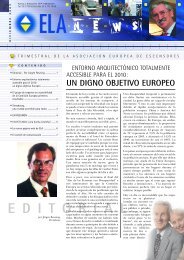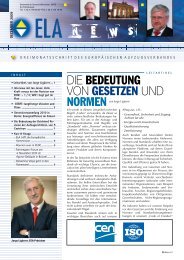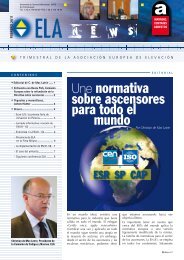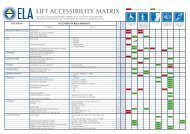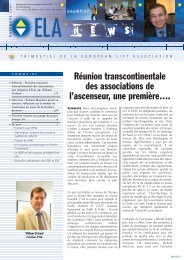WP6-Brochure-E4 brochure - ELA European Lift Association.
WP6-Brochure-E4 brochure - ELA European Lift Association.
WP6-Brochure-E4 brochure - ELA European Lift Association.
You also want an ePaper? Increase the reach of your titles
YUMPU automatically turns print PDFs into web optimized ePapers that Google loves.
3.9 Efficient Escalators and Moving Walks<br />
As in lifts, the efficiency of escalators’ components is of the utmost importance. High efficiency<br />
motors, drives, transmissions, bearings, etc. can yield significant savings and are, in most cases,<br />
cost‐effective. As an example, planetary, helical, and hypoid helical gears can reach efficiencies<br />
of up to 96% and are now available from many manufacturers as a substitute for lower<br />
efficiency worm gears. Proper maintenance and lubrication of components also helps keep the<br />
equipments efficiency at its maximum.<br />
Normally, escalators are always moving regardless of load conditions, causing energy wastage<br />
when there are no passengers to move. One of the biggest opportunities for improvement is,<br />
therefore, to adequately adjust the speed to the passenger demand at any given time by the<br />
use of variable‐voltage or variable‐voltage variable‐frequency converter.<br />
In the first option, the escalator is kept travelling at nominal speed. By reducing the voltage<br />
under low load conditions the magnetising current is also reduced, decreasing the motor iron<br />
losses, which are proportional to the square of the magnetic flux. Joule losses are also reduced<br />
while the power factor is increased. This type of equipment incorporates a soft‐start and is<br />
small enough to replace the starter fitted in existing systems.<br />
When using VVVF drive, the speed can be adjusted to match the passenger demand, thus<br />
reducing energy consumption and wear. Unlike other options (see below), VVVF drives provide<br />
very smooth, almost imperceptible speed transitions. Typically, three modes of operation are<br />
provided by variable speed escalators. After a predefined period of inactivity, escalators<br />
reduce their speed and reach the so called “reduced‐speed” mode. The consumption in this<br />
“reduced‐speed” mode is more or less half the consumption in the normal operation mode.<br />
After reaching this mode of operation, and after another predefined interval of time, the<br />
escalator is put into a STOP mode. At this STOP mode, only the control system and the<br />
passenger detection system (pressure mats, photocells or infra‐red beams) are kept running.<br />
When a passenger is detected, the escalator slowly begins to move again, gently accelerating<br />
until it reaches nominal speed. Depending on the intensity of use of the escalator, this option<br />
can save up to 40% of the escalators energy consumption.<br />
Figure 3‐36 illustrates escalator’s power consumption at different operating modes.<br />
49





